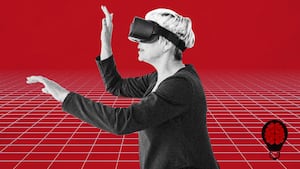Luis Eduardo Garrido couldn’t wait to test out his colleague’s newest creation. Garrido, a psychology and methodology researcher at Pontificia Universidad Católica Madre y Maestra in the Dominican Republic, drove two hours between his university’s campuses to try a virtual reality experience that was designed to treat obsessive-compulsive disorder and different types of phobias. But a couple of minutes after he put on the headset, he could tell something was wrong.
“I started feeling bad,” Garrido told The Daily Beast. He was experiencing an unsettling bout of dizziness and nausea. He tried to push through but ultimately had to abort the simulation almost as soon as he started. “Honestly, I don’t think I lasted five minutes trying out the application,” he said.
Garrido had contracted cybersickness, a form of motion sickness that can affect users of VR technology. It was so severe that he worried about his ability to drive home, and it took hours for him to recover from the five-minute simulation. Though motion sickness has afflicted humans for thousands of years, cybersickness is a much newer condition. While this means that many of its causes and symptoms are understood, other basic questions—like how common cybersickness is, and whether there are ways to fully prevent it—are only just starting to be studied.
After Garrido’s experience, a colleague told him that only around 2 percent of people feel cybersickness. But at a presentation for prospective students, Garrido watched as volunteers from the audience walked to the front of an auditorium to demo a VR headset—only to return shakily to their seats.
“I could see from afar that they were getting sweaty and kind of uncomfortable,” he recalled. “I said to myself, ‘Maybe I’m not the only one.’”
As companies like Meta (née Facebook) make big bets that augmented reality and virtual reality technology will go mainstream, the tech industry is still trying to figure out how to better recruit users to the metaverse, and get them to stay once there. But experts worry that cybersickness could derail these plans for good unless developers find some remedies soon.
The issue is actually something of a catch-22: In order to make VR more accessible and affordable, companies are making devices smaller and running them on less powerful processors. But these changes introduce dizzying graphics—which inevitably causes more people to experience cybersickness.
At the same time, a growing body of research suggests cybersickness is vastly more pervasive than previously thought—perhaps afflicting more than half of all potential users. Proponents of a “headset in every home” vision for VR must make sure first-timers don’t leave the experience and lose their lunch. A buggy beta hits differently when it’s your health and comfort on the line. And depending on how long the effects of cybersickness last for an individual, VR technology may not be just uncomfortable for them, but literally unusable.
“If people have this type of bad experience with something, they’re not going to try it again,” Garrido said.
Thanks to VR, Charles Oman has seen Earth from the International Space Station. He’s watched the Emmy-nominated documentary Traveling While Black, which immerses viewers in the history of race relations and restricted movement for Black Americans, using VR to give viewers a first-hand glimpse at what the Black experience is like. But he wishes he could have shared these experiences and all that VR headsets have to offer with his wife.
“She won’t wear the damn thing,” he told The Daily Beast. “She is very susceptible to motion sickness of all kinds, and she doesn’t like the dizziness and the uncertainty about orientation. And so getting over that hump, for her—she’s got better things to do. I think a lot of people are that way.”
If anyone could offer a foolproof solution to motion sickness, it would be Oman: He has studied motion sickness at MIT for 50 years, and has seen the field tackle the condition first at sea, then in space, and now in the metaverse.
Seasickness, space sickness, and cybersickness are all heads of the same hydra, caused when a person’s brain receives unexpected and conflicting signals. According to Oman, every time the head moves, the brain anticipates how canals in the inner ear, the eyes, and other points in the body will respond and uses the feedback to rebalance. A mismatch between what the brain expects and what it gets causes symptoms of dizziness, nausea, cold sweats, pale skin, and fatigue. But what does that look like in practice?
An illustrative example of this mismatch befell the Roman philosopher Seneca, which he described in a letter written in the first century. As he sailed across the Bay of Naples on a rocking vessel, his eyes gave him signals that he was stationary while his body told his brain otherwise. Distressed, he told the ship’s captain to drop him off anywhere, later writing “I was suffering too grievously to think of the danger, since a sluggish seasickness which brought no relief was racking me.” (He ended up diving out of the boat and swimming to shore.)
Before NASA took interest in motion sickness in the 1970s, belly binders and ludicrous diets were touted as potential cures. Since then, researchers have developed tried-and-true methods of preventing the condition—such as medication that weakens the mismatch signals received by the brain, and exercises that realign your body’s feedback systems (for example, looking out the windshield of a car instead of down at a phone).
VR developers have taken some cues from these solutions. Some have introduced an artificial “horizon” in VR video that does seem to lower the severity of motion sickness—but unfortunately does not eliminate it completely. Most guidance recommends taking a 10- to 15-minute break every half hour to delay the onset of cybersickness, but these numbers have not been rigorously tested. For some, like Garrido, a short break is nowhere near enough time to recover. But was he an outlier?
Once Garrido saw what happened at the demonstration for prospective students, he decided to conduct a study to see how common cybersickness really is. Scouring the literature, he couldn’t find a clear answer because of the size of most studies: “Many enroll 15, 20, 25 people,” he said. “Since I’m a math person, I knew these studies had all kinds of problems.” With sample sizes that small, there’s a chance that the participants enrolled do not give the full picture of the condition’s effects.
So Garrido and his team decided to run their own study, recruiting 92 people to try the same VR program that first made him sick. In the VR experience, participants explored a 3D kitchen and public restroom, two environments that are commonly used in OCD therapy. They navigated around for 10 minutes with a joystick, a method of “transportation” that has fallen out of favor in VR game development in favor of simple point-and-click teleporting like in Google Maps’ Street View. (Garrido’s critics might contend the study is using obsolete tech, though it should be noted flight simulators and other applications that want to increase a user’s immersion will still employ a joystick, as it more closely mimics natural movement.)
In sharp contrast to the 2 percent estimate Garrido had been told, the results from his study, published earlier this year, indicated that more than 65 percent of people experienced symptoms of cybersickness, and more than one-third of these people experienced severe symptoms. Twenty-two participants decided to stop the simulation before the 10 minutes were up.
These results should concern the developers of other VR applications, Garrido said, since the only movement in the simulations came from the users’ own actions (unlike, say, a roller coaster or flying experience). The experiences were designed to be tame.
“You can think of our study as a baseline because our environments don’t do anything to cause cybersickness,” he said. “The general trend is that as time goes by, people will get worse. You need to know that if you are planning a 20-minute or longer immersion.”
Cybersickness doesn’t just arise from the controls of a VR experience. It can be built into the fabric of hardware (individual headsets) and software (experiences, apps, and simulations). Kyle Ringgenberg, an AR and VR developer and the co-founder of software company Dimension X, said that there are two major sensory conflicts that lead to cybersickness in VR. The first is the same brain-body mismatch that leads to car and seasickness, but the second is a different physiological response—and potentially even harder to fix. When we look out at the world in front of us, our eyes automatically focus on an object based on its perceived distance from us. A VR headset projects images a set distance away from a viewer, but when a virtual object appears close, it may seem blurry since the person’s eyes are trying to focus on it as if it truly were.
The combination of these two forms of cybersickness can lead to headaches for users and developers alike.
“If my iPhone doesn’t load a page instantly, I might grumble about it, but that’s the end of it,” Ringgenberg told The Daily Beast. “If my VR app stutters on me, I might physically get sick. That does keep people away from this technology.”
First-time VR developers may force the user to run around a scene independent of their physical motion, not knowing any better. They may also be ignorant of some of the other best practices for reducing cybersickness, like lowering lag to under 20 milliseconds or increasing the frame rate to 90 frames per second, Ringgenberg said. On the other hand, there’s no easy fix for the second form of cybersickness, called vergence-accommodation conflict.
There are some signs that developers are taking cybersickness seriously, whether because of a newfound appreciation for the condition’s prevalence, or because updates to the technology finally allow them to tackle some of the devices’ initial shortcomings.
“A lot of people don’t realize how much progress has been made just in the last four or five years,” Oman said. Predictive head tracking to minimize the sensory conflict a person might feel has “not eliminated [cybersickness], but it’s really, really helped,” he added.
But just as telling are recent missteps from industry leaders. The display for the first Quest headset made by Oculus (which is owned by Meta) refreshed at a rate of 72 frames per second, low enough to cause dizziness and nausea. It’s hard to speculate why the company would have chosen this display, Ringgenberg said, but it’s easy to imagine some first-time users trying out the Quest and becoming completely turned off to VR because of a bad experience.
Inarguably, it has been helpful for the development of VR that works for everyone for the industry to figure out the root causes of cybersickness; however, playing the blame game by criticizing individual apps and headsets for faulty hardware or inconsiderate, non-adaptive gameplay misses the big picture. Cybersickness is a medical condition that is affecting users today. Without a far-reaching fix in the pipeline, this downright nasty side effect threatens to sideline VR to a few niche communities, and ultimately, spell doom for the metaverse.










